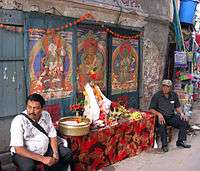Paubha
Paubhā (Devanagari: पौभा) is a traditional religious painting made by the Newar people of Nepal.[1] Paubhas depict deities, mandalas or monuments, and are used to help the practitioner meditate. The Tibetan equivalent is known as Thangka.[2][3]


Most paubhas show Buddhist subjects, but a few have Hindu themes. The paintings are made to earn religious merit both for the artist and the patron. Newar Buddhists commission artists to paint paubhas which are displayed during festivals and other special occasions. The traditional painters of paubhas are the Chitrakar caste who are known as Pun (पुं) in Nepal Bhasa.[4]
History
A paubha of Amitabha Buddha at the Los Angeles County Museum is believed to be the earliest specimen which is done in a style dating from the 11th century[5] (Nepal Sambat 485). It is a specimen of the skill of Newar artists that made them sought-after throughout the Himalayan region and as far as China.[6] Newar artists and merchants took the paubha art to Tibet from which the Tibetan thangka evolved.[7]
The painting
Paubhas are painted on a rectangular piece of canvas. It is prepared by applying a mixture of buffalo glue and white clay on it. The surface is then rubbed with a smooth stone to give it polish. The painting is done according to the rules and dimensions handed down by tradition, and artists cannot exercise their creativity.[8]
The paint is made from minerals and plants. Gold and silver paint are also used on paubhas. The eyes of the deity are painted when the rest of the painting has been completed, and is known as "mikhā chāyekegu" (opening the eyes).[9] Brocade is sewn to the edge of the paubha to make a frame for display.
From a composition perspective, the surface of Paubha is usually occupied of a large figure in the center that is placed inside a shrine and surrounded by registers of smaller figures on the sides; the background is usually filled in with natural elements such as rocks rendered in abstract patterns. The color is often deep and subdued with subtle shadings of the figures and exquisite renderings of details that are the hallmarks of early Nepalese paubhas[10]
Exhibitions
An annual exhibition of statues of Dipankara Buddha and paubhas is held in sacred courtyards in the Kathmandu Valley. The ceremony is known as Bahidyah Bwayegu (बहीद्यः ब्वयेगु), and is held during the month of Gunla. Gunla, which corresponds to August, is a holy month for Newar Buddhists. Groups of devotees led by musical bands make a tour of the courtyards to view the displays. In recent times, the traditional exhibitions have become fewer and shorter due to fear of art thieves.[11]
Contemporary Paubha
20th Century is a traditional Nepalese painting that depicts Hindu and Buddhist gods and Buddhas in detail with rock paint. In the latter half of the 20th century, a painter incorporating Western-style realistic expressions appeared, but in recent years he strongly pushed that tendency, especially using oil painting, contemporary jewelry with vibrant color
Most of the Paubha has no name and date due to religious practice paint, Anandamuni Shakya was born in (1903- 1944), close to the Buddhist temple of Itum-bahal in the old market area of Kathmandu. His paubha has contemporary touch and Udaya Charan Shrestha born in 1964 heart of Kathmandu who follows Ananda Muni’s style , Being Newar Shrestha’s deep knowledge of rituals and objects in daily life are also the recourses in his way of Paubha paintings, visualization of his circumstances and he applied dyanamic compositions in his painting which is a unique and influence of modernity including contemporary jewaries use in his art.
References
- Chitrakar, Madan (2012). "Paubha Art". Nepali Art. Kathmandu: Teba-Chi Studies Centre. pp. 35–52. ISBN 978-9937-2-4933-1.
- Shakya, Min Bahadur (2011). "Paubha Paintings". Arts of Nepal. Retrieved 24 September 2012.
- Macdonald, A.W. and Stahl, Anne Vergati (1979) Newar Art: Nepalese Art during the Malla Period. New Delhi: Vikas Publishing House.
- Chitrakar, Madan (2000) Tej Bahadur Chitrakar: Icon of a Transition. Kathmandu: Teba-Chi (TBC) Studies Centre. ISBN 99933-879-7-5. Page 17.
- Shakya, Min Bahadur (2011). "Paubha Paintings". Arts of Nepal. Retrieved 24 September 2012.
- "The Stuart Cary Welch Collection". Sotheby's. Retrieved 24 September 2012.
- "The Nepalese Legacy in Tibetan Painting". Rubin Museum of Art. Archived from the original on 20 November 2011. Retrieved 25 September 2012.
- Pradhan, Ujjwal (10 July 2010). "A heritage in peril". Archived from the original on 25 March 2011. Retrieved 24 September 2012.
- Gurung (Pradhan), Renuka (2011). "Paubha Painting: The Traditional Art of Nepal". Arts of Nepal. Retrieved 24 September 2012.
- Huu Phuoc Le, Le Huu Phuoc, Buddhist Architecture ', Grafikol, 2010
- Shakya, Min Bahadur (2011). "Paubha Paintings". Arts of Nepal. Retrieved 26 September 2012.